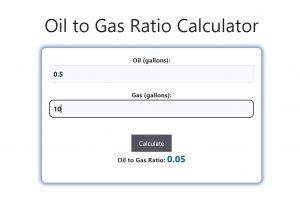About Oil to Gas Ratio Calculator (Formula)
When operating two-stroke engines, such as those found in lawnmowers, chainsaws, and motorcycles, it’s crucial to mix oil and gas in the correct ratio to ensure optimal engine performance and longevity. The oil lubricates the engine, preventing it from overheating and wearing down. Incorrect oil-to-gas ratios can lead to engine damage, reduced performance, or even complete failure. Our Oil to Gas Ratio Calculator simplifies the process of calculating the correct mixture, ensuring your engine runs smoothly.
Formula
The formula to calculate the oil-to-gas ratio is:
Oil to Gas Ratio = Oil (gallons) / Gas (gallons)
This ratio determines the proportion of oil to be mixed with gasoline to achieve the desired fuel mixture for your engine.
How to Use
- Measure the amount of oil you plan to add to the fuel mixture, in gallons.
- Measure the amount of gasoline you will be mixing with the oil, in gallons.
- Enter these values into the Oil to Gas Ratio Calculator.
- Click the “Calculate” button to find the oil-to-gas ratio.
This simple tool ensures you get the correct ratio, whether you’re mixing small or large quantities of fuel.
Example
Let’s say you are mixing 0.5 gallons of oil with 10 gallons of gasoline. Using the formula:
Oil to Gas Ratio = 0.5 gallons of oil / 10 gallons of gas = 0.05
This means your oil-to-gas ratio is 0.05, which can be expressed as a 1:20 ratio (1 part oil to 20 parts gasoline). This ratio ensures your engine gets the proper lubrication for optimal performance.

FAQs
- What is an oil-to-gas ratio? An oil-to-gas ratio refers to the proportion of oil to gasoline in a fuel mixture, typically used in two-stroke engines to ensure proper lubrication.
- Why is the correct oil-to-gas ratio important? Using the correct ratio prevents engine damage, overheating, and wear by ensuring the engine is properly lubricated.
- How do I calculate the oil-to-gas ratio? You can calculate the ratio using the formula: Oil to Gas Ratio = Oil (gallons) / Gas (gallons).
- What is a common oil-to-gas ratio for two-stroke engines? Common ratios are 1:50 (1 part oil to 50 parts gasoline) or 1:40, depending on the manufacturer’s recommendation.
- Can using too much oil harm my engine? Yes, using too much oil can cause excessive smoke, fouled spark plugs, and carbon buildup, which can reduce engine performance.
- What happens if I don’t use enough oil in the mixture? Not using enough oil can cause insufficient lubrication, leading to engine overheating, increased wear, and potentially serious damage.
- How do I know the correct oil-to-gas ratio for my engine? Always refer to the manufacturer’s manual for the recommended oil-to-gas ratio specific to your engine model.
- Can I use any type of oil for my two-stroke engine? No, you should use two-stroke engine oil specifically designed for mixing with gasoline. Regular motor oil is not suitable for two-stroke engines.
- How do I mix oil and gas for my engine? Measure the correct amount of oil and gas, pour them into a container, and mix thoroughly by shaking the container before filling your engine’s tank.
- Is it better to use premixed fuel instead of mixing my own? Premixed fuel is convenient and eliminates the risk of incorrect ratios, but mixing your own fuel can be more cost-effective.
- How do I store mixed fuel? Store mixed fuel in an airtight, labeled container, and use it within 30 days to prevent degradation of the fuel and oil mixture.
- What is the difference between synthetic and conventional two-stroke oil? Synthetic oil typically provides better performance, cleaner burning, and longer engine life compared to conventional two-stroke oil.
- How does altitude affect my oil-to-gas ratio? Higher altitudes may require slight adjustments to the mixture, as engines can run leaner in thin air. Consult your engine’s manual for specific recommendations.
- Can I use ethanol-blended gasoline in my two-stroke engine? Ethanol-blended gasoline can cause problems in two-stroke engines, such as fuel separation and gumming. Non-ethanol gasoline is often recommended.
- Do different engines require different oil-to-gas ratios? Yes, different engines may require different ratios. Always check your engine’s specifications to determine the correct mixture.
- Can I reuse leftover mixed fuel? Yes, but be aware that mixed fuel can degrade over time. If storing for more than 30 days, consider adding a fuel stabilizer.
- What are the signs of an incorrect oil-to-gas ratio? Signs of an incorrect ratio include excessive smoke, engine knocking, poor performance, or difficulty starting the engine.
- How do I dispose of unused mixed fuel? Unused mixed fuel should be disposed of properly at a hazardous waste facility. Do not pour it down drains or into the environment.
- What safety precautions should I take when mixing oil and gas? Always mix fuel in a well-ventilated area, away from open flames, and store fuel in approved containers. Wear protective gloves and eyewear if needed.
- Can I adjust the oil-to-gas ratio for performance tuning? Some advanced users may adjust the ratio slightly for performance tuning, but it’s essential to stay within safe limits to avoid engine damage.
Conclusion
The Oil to Gas Ratio Calculator is a valuable tool for anyone operating two-stroke engines. By ensuring the correct oil-to-gas mixture, you can optimize engine performance, reduce wear, and extend the life of your equipment. Whether you’re maintaining a lawnmower, chainsaw, or motorcycle, this calculator makes it easy to get the right ratio every time, ensuring your engine stays properly lubricated and running smoothly.
Related:
